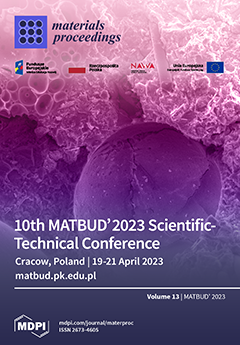Mater. Proc., 2023, MATBUD’ 2023
10th MATBUD’2023 Scientific-Technical Conference
Cracow, Poland | 19–21 April 2023
Volume Editors:
Katarzyna Mróz, Cracow University of Technology, Poland
Tomasz Tracz, Cracow University of Technology, Poland
Tomasz Zdeb, Cracow University of Technology, Poland
Izabela Hager, Cracow University of Technology, Poland
Printed Edition Available!
- Issues are regarded as officially published after their release is announced to the table of contents alert mailing list.
- You may sign up for e-mail alerts to receive table of contents of newly released issues.
- PDF is the official format for papers published in both, html and pdf forms. To view the papers in pdf format, click on the "PDF Full-text" link, and use the free Adobe Reader to open them.



